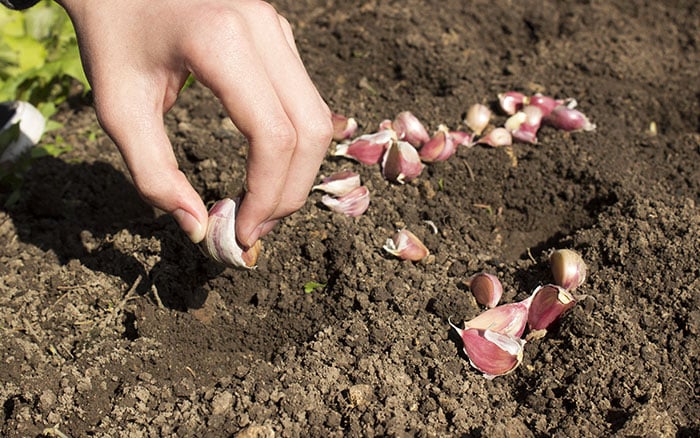Though our gardens may have slowed down a bit, they never come to a halt because growing and gardening is an activity for all year round. So, don’t stop gardening, and use the ground and your greenhouse to overwinter crops and prepare for the new year.
Prep and plant
Get ahead of the game in autumn and plant veg that can spend time in the ground whilst it’s dormant so that they are ready to spring to life in the new year in growing season.
Here are a few crops that you can overwinter in your garden:
Autumn planted garlic

Simply plant the clove in the ground, around 18cm apart. For the cloves to form into a bulb, they need around 6 weeks of temperatures below 10˚C. This makes autumn the perfect time to plant them.
The great thing about growing garlic is they don’t require much room or effort to grow.
To care for them, ensure the area is cleared of weeds, is watered when dry. Then, in early summer they should be ready to harvest.
Once the foliage begins to turn yellow, the bulbs can be lifted gently with a fork.
Kale
Packed full of nutrition, including vitamins A, K, and C, they are also low in calories making them incredibly nutrient-dense. So, get started with growing your own superfoods this winter.
Not only is it good for you, but it’s so easy to grow too.

Sow seeds in a modular tray around 2cm deep, then plant them out before they become restricted in the container.
When planted out, kale will grow well with a deep mulch and watering regularly. On the other hand, kale that’s grown in an unheated greenhouse will give you a harvest that is sweeter and more tender.
Leaves can be removed from the top of the plant when they’re ready to be harvested. Then, they can be added to stews and soups!
Broad beans

For an early crop of broad beans, seeds can be sown in a cold greenhouse or directly into the ground. When sowing in the ground, you’ll need protection from cloches.
Sowing seeds in November will allow them to germinate in around 2 weeks. Then over winter they are dormant in the ground until spring when their growth continues.
Sowing directly into the ground will be suitable for sheltered gardens, but for gardens in the North, protection may be required.
When sowing, space the seeds 20cm apart and once they germinate, they will need some support from stakes. Once flowering begins, sufficient watering will help to boost growth.
Broad beans will be ready to harvest when they reach just over 7cm long to cook whole, or if you are harvesting to shell the beans, wait until they are able to be seen through the pod.
Chard
The brightly coloured leaves of chard is making it a new popular plant to grow. Chard is a slow grower, and over the winter when temperatures drop in November, they slow their growth and become dormant, waiting for the spring until they perk back up.
Although, you can work around this by planting as early as possible in autumn to get ahead so the plants reach maturity before the November chills, or grow them in a greenhouse, polytunnel or cloche to keep them a little bit warmer.

Similarly, a thick mulch around the base will ensure the roots stay warm over winter.
Begin harvesting from the outer leaves when they are tender, and work inwards. By cropping regularly, it’ll encourage new, tender growth.
Spring cabbage

Another plant for overwintering that will be ready for harvest the following spring is spring cabbage. Start by sowing indoors into a modular tray in July or August, then transplant them into the ground once they have around 5 or 6 leaves.
When transplanting, ‘puddle’ in the plants, which means to fill the hole with water a few times before adding the soil, this will mean they will need little water but in dry periods, they may appreciate a soak every 2 weeks.
The spring cabbages will be ready to harvest by cutting the stem just above ground level. Also, by cutting a deep cross in the stump of them, you will get a second crops of smaller cabbages too.
Microgreens
Or, if you simply can’t wait, growing microgreens on your windowsill is an ideal way of getting some home-grown flavour into your winter dishes. In as little as 7 days you can have a harvest of microgreens including radish, coriander, spinach, and basil.
All you need is a windowsill, a container, kitchen roll, water, and seeds, which makes this perfect for urban gardeners, or families with little ones to keep them entertained.


Leave A Comment